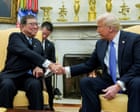
The global trade landscape is witnessing transformative changes with the emergence of new alliances and landmark trade agreements. Recent developments highlight significant strides made by world leaders in fostering economic partnerships that promise to bolster their respective economies while navigating the complex intricacies of international relations.
In an eagerly anticipated move, former US president Donald Trump announced a breakthrough trade deal with Japan, ending weeks of intense negotiations that were marked by political and economic uncertainty. The announcement of the agreement, described by Trump as a “massive Deal,” projects that Japan will invest an impressive $550 billion into the United States. This development is expected to alleviate some of the economic pressures that had emerged in Tokyo and had caused considerable speculation about the future of Prime Minister Shigeru Ishiba’s leadership. This landmark deal showcases the enduring alliance between the United States and Japan, highlighting their commitment to mutual economic growth and cooperation in a rapidly evolving global economy.
Meanwhile, across the Atlantic, Prime Minister Narendra Modi of India embarked on a significant state visit to the United Kingdom, culminating in the signing of a historic free trade agreement. This landmark pact signifies a vital political and economic triumph for both nations amid ongoing global trade tensions. The agreement is hailed as the most economically impactful trade deal the UK has secured since its departure from the European Union, particularly boosting key sectors such as the car and whisky industries. For India, it represents the nation’s first major free trade agreement outside the Asian continent, underscoring its strategic shift towards fostering global economic partnerships.
This accord between the UK and India is emblematic of a longer-term economic partnership, with analysts pointing to the potential for strengthened ties and mutual benefits. The agreement also incorporates key provisions, such as visa concessions for Indians, which aim to enhance people-to-people connectivity and workforce mobility. However, some sensitive matters remain unresolved, hinting at future discussions that will further refine this evolving relationship.
These pivotal agreements reflect a broader trend of nations seeking new avenues for collaboration and growth amidst a backdrop of shifting trade policies and international dynamics. The emphasis is on creating robust frameworks that facilitate trade, investment, and innovation, propelling economies towards sustainable development.
As these agreements come into effect, they symbolize more than just economic transactions. They represent a testament to the resilience and adaptability of nations determined to thrive in an interconnected world. The potential for economic prosperity gained through these partnerships serves as a beacon of hope and possibility, demonstrating a firm commitment to global cooperation and shared prosperity.
As these agreements unfold, stakeholders across industries and markets will be observing closely the tangible impacts they will have on the global economy. In this era of complex geopolitical landscapes, strategic economic engagements such as these set the stage for a promising future, marked by enhanced collaboration and shared progress.
Source: {link}
